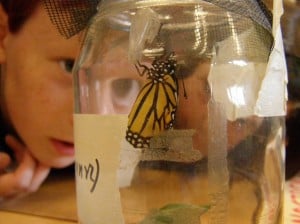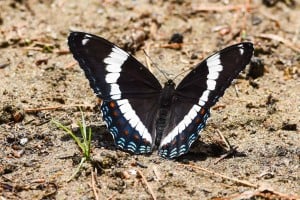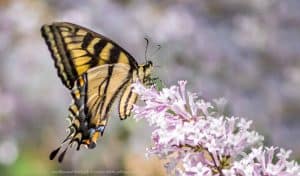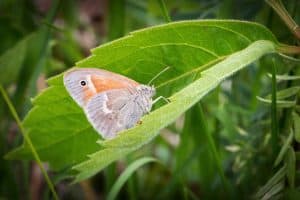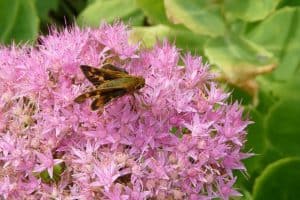July is a great time to get to know these beautiful insects.
My special affection for butterflies began as a classroom teacher. Each September, I would collect monarch caterpillars for my students to raise. They would watch and document each stage of metamorphosis with rapt attention. We were often able to see the caterpillars spin a silk mat from which to hang in a J-shape before shedding their skin for the last time, revealing the lime-green chrysalis. The kids’ excitement would only increase over the following days as the black, orange, and white wing patterns became visible through the chrysalis covering. Then, one morning at about 9 o’clock, some student would yell, “The monarch’s coming out of its chrysalis!” We would then watch with amazement as the wet, crumpled adult pumped hemolymph liquid through its small, crimped wings until they expanded to full-size. At the end of the school day, we would head outside and release the monarch to a chorus of, “Bon voyage. Have a great trip to Mexico!”
The Kawarthas is home to approximately 100 species of butterflies, which represents almost two-thirds of the species occurring in the entire province. Identifying and photographing them is a wonderful summer pastime. Not only are butterflies easy to observe, but they turn up almost everywhere. Unlike birding, which sometimes requires getting up at the crack of dawn and dealing with inclement weather, watching butterflies is a more civilized affair. These gentle insects are rarely on the wing before nine o’clock, and they are most active on warm, sunny days. Right now is a great time to get to know these insects. More species are active in July than at any other time of year.
This month, it should also be possible to see species that are usually more typical of June. According to local butterfly expert Jerry Ball, the cold, wet spring we experienced has delayed the emergence of many species by about 10 days. He is encouraged, however, by the number of monarchs that returned this spring. These “grandchildren” of the monarchs that migrated to Mexico last fall have already laid eggs. We can therefore expect monarch sightings to increase substantially over the next couple of weeks when a new generation of adults will be flying. If the weather cooperates – warm, sunny days with an average amount of rain – we should have another good summer for this species at risk. The overwintering population in Mexico was 144% higher this past winter as compared to the winter of 2018.
Where to look
As we approach mid-July, our roadsides, fields, wetland borders, and gardens are increasingly lush with fragrant, colourful flowers. Many of these are important sources of nectar. Butterflies are especially attracted to common milkweed, swamp milkweed, spreading dogbane, viper’s-bugloss, purple vetch, wild bergamot and orange hawkweed. Later in the summer, plants like Joe-Pye-weed, goldenrods and asters are also butterfly magnets. In gardens, butterflies are particularly fond of purple coneflower, globe thistle, butterfly bush, and Mexican sunflower (Tithonia).
Butterflies, however, are not just attracted to flowers. Many species such as white admirals, mourning cloaks and eastern commas also like to bask on roads. By extending their wings, they absorb the sun’s warmth in order to elevate their body temperature for more efficient flight. You will also find butterflies congregating around the muddy edge of puddles or perched on animal dung. Both mud and dung serve as an important source of minerals, amino acids and nitrogen. A third place to look for butterflies is on tree trunks, especially if they are oozing sap. In fact, one species, the northern pearly-eye, is a shade lover and routinely lands on the trunks of forest trees.
Although butterflies turn up nearly everywhere, some locations are routinely better than others. I asked Martin Parker, former president of the Peterborough Field Naturalists, to share some of his favourite butterfly-watching destinations. Martin recommends walking or cycling along any of our local rail-trails. He particularly likes the section of the Rotary-Greenway Trail from Trent University to Lakefield, the Trans-Canada Trail between Cameron Line and County Road 38, and the BEL Rotary Bridgenorth Trail from Seventh Line to Fifth Line. The mix of wetland, field and woodland habitats make these trails particularly rich in butterfly diversity. If you’re willing to travel a little further afield, he also recommends Petroglyph Provincial Park and both Jack Lake and Sandy Lake Roads. The latter is located off County Road 46, about 25 minutes north of Havelock. Sandy Lake Road is considered one of the best butterfly destinations in all of Ontario, especially because of its wide variety of skippers like the mulberry wing.
What’s flying now?
Most butterfly species have a specific flight period, which is the time of year in which they fly. Two easy-to-identify species that are common right now are the eastern tiger swallowtail and the white admiral. The swallowtail’s large size and yellow wings striped in black make it hard to miss. The white admiral, too, is very distinctive. Watch for a black butterfly with a large white band across each of the four wings. Some other common species to watch for in mid-July are the cabbage white, clouded sulphur, northern crescent, common ringlet, summer azure, great-spangled fritillary, red admiral, European skipper, and Dun’s skipper. Skippers are tiny, grey and/or orange, moth-like butterflies.
In the coming days and weeks, you should also watch for the giant swallowtail, Canada’s largest butterfly. Because of its size and weight, it’s usually unable to land on flowers and must hover as it feeds. These butterflies are new to the Kawarthas, having extended their range northward as a result of our warming climate.
Viewing tips
Here are some pointers to keep in mind to make the most of butterfly watching.
1. The best way to approach a butterfly is from behind, being careful to avoid any sudden movements. As Parker says, “Be patient and don’t rush them. Let the butterfly settle in and start nectaring.” You should also try to avoid casting a shadow on the insect. Being sun-loving creatures, a shadow can cause them to fly away.
2. Getting good looks at butterflies is easiest with a pair of close-focusing binoculars. For optimal viewing, you should be able to stand up and focus on your toes. A good pair of binoculars will allow you to identify nearly all the butterflies you’re likely to see.
3. A butterfly net can be helpful when it comes to look-alike species like the skippers. Carefully transfer the butterfly from the net to a small jar or Zip-lock bag for close-up viewing.
4. A camera with a zoom lens also comes in handy. By taking a picture, you can identify the butterfly at your leisure. You can also upload the photo to iNaturalist.org where someone else will identify it for you.
5. Pay special attention to the butterfly’s size, wing shape, colour and patterning. The pattern on the underside of the wing, usually visible as the butterfly feeds, is especially important for identification purposes.
6. Learn to identify the plants that attract butterflies, either for nectar or as “larval plants” on which to lay eggs. Monarchs, for example, only lay their eggs on milkweed.
7. To find a given species, research the time of year it flies and its preferred habitat.
8. You will also need a guidebook. Parker recommends “The Pocket Guide to Butterflies of Southern and Eastern Ontario”, by Rick Cavasin. You can pick up a copy of this this inexpensive, laminated fold-out at the Avant-Garden Shop at 165 Sherbrooke Street in Peterborough. For a more detailed guide, I recommend “The Butterflies of Ontario”. One of the co-authors is Colin Jones, a Peterborough naturalist and biologist.
Butterfly count
On July 20, local butterfly aficionados will be taking part in the 22nd annual Petroglyph Butterfly Count. Jerry Ball is the compiler and organizer. If you wish to participate, phone Martin Parker at 705-745-4750 or email him at mparker19@cogeco.ca. The count is a fun day in which beginners are paired with more experienced watchers. It will be interesting this year to see the effects – if any – of the cold, wet spring. Like the Christmas Bird Count, butterfly counts provide a snapshot of butterfly numbers from one year to the next. In this way they are an important tool in documenting changes in populations. Numerous studies have shown that insect numbers are plummeting in many parts of the world. The “windshield phenomenon” provides anecdotal evidence of this alarming trend. Most anyone of a certain age can probably remember how windscreens would become covered in dead insects after just a short drive in the country. No longer is this the case. The threat of ecological disruption from declining insect numbers should be of concern to everyone.
Climate Crisis News
If you’re looking for a good book to read this summer, I highly recommend “The Overstory”, by Richard Powers. It won the 2019 Pulitzer Prize in Fiction and is being touted as the first great American ecological novel. In telling the story of people whose lives have been profoundly affected by trees, Powers incorporates the latest tree science. This includes how trees engage in social behaviours and communicate with one another. The Overstory also fits well within the growing genre of “climate fiction” by exploring the effects of humans’ impact on the Earth. As Powers writes, “Life will cook; the seas will rise. The planet’s lungs will be ripped out. And the law will let this happen, because harm was never imminent enough. Imminent, at the time of people, is too late. The law must judge imminent at the speed of trees.”
